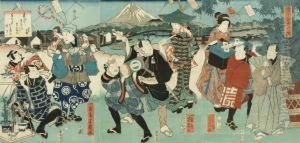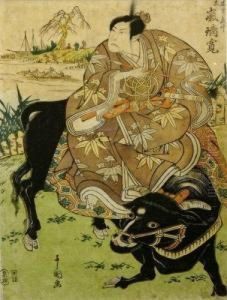Yoshikuni Paintings
Yoshikuni was a Japanese ukiyo-e artist known for his woodblock prints. He was active during the late Edo period, a time characterized by strict social orders, economic growth, and a closed foreign policy. While the exact dates of his birth and death are not clearly documented, his artistic activity is recorded between the years 1813 and 1832.
Yoshikuni was a pupil of the Utagawa school, one of the most influential schools of Japanese woodblock printing. He was likely trained under Utagawa Toyokuni I, the leader of the school at the time. Yoshikuni's works primarily focus on kabuki, the popular form of theater in Japan, which was a common subject for ukiyo-e artists of the period. His prints often depicted scenes from kabuki plays and portraits of actors in character, capturing the flamboyance and drama of the performances.
Despite his connection with the Utagawa school and the prominence of his subjects, Yoshikuni did not achieve the same level of fame as some of his contemporaries, such as Utagawa Hiroshige or Katsushika Hokusai. The Utagawa school was known for producing a large number of artists, and competition within the school itself was fierce.
Yoshikuni's works are characterized by their bold use of line and color, typical of the Utagawa style. However, his prints are less common than those of his more famous peers, which has led to a relative obscurity in modern times. Nonetheless, his contributions to the ukiyo-e genre provide insight into the cultural and artistic practices of the late Edo period.
The details of Yoshikuni's later life and the circumstances of his death remain largely unknown. Like many ukiyo-e artists, his life was not well-documented, and he is primarily remembered through the legacy of his prints. Collectors and scholars of Japanese art continue to study his work to gain a deeper understanding of the era he represented and the school to which he belonged.

